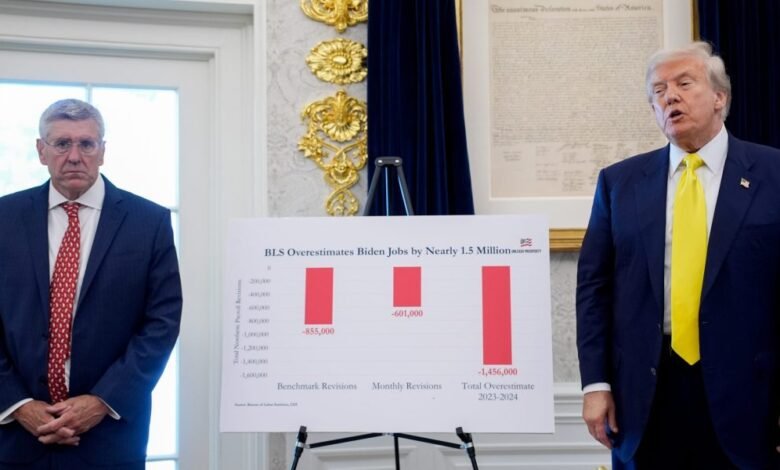Two Trump-appointed economists—and longtime friends—are clashing over Trump’s jobs data

Former Bureau of Labor Statistics (BLS) Commissioner William Beach—a Trump nominee—said every number on the jobs chart President Donald Trump touted in the Oval Office on Thursday was wrong.
Still bitter over last week’s “rigged” jobs report, which showed weaker-than-expected job growth, Trump convened an impromptu press conference Thursday evening to showcase graphs with what he called “all-new numbers.”
Stephen Moore, a Heritage Foundation economist, said during the press conference that the numbers justified Trump’s firing of former BLS Chief Erika McEntarfer. He estimated that over the last two years of President Joe Biden’s administration, the BLS overestimated job creation by 1.5 million jobs.
In an interview with Fortune, Moore said he disagreed with the president that the numbers were rigged on purpose. He never met McEntarfer, he explained, but said it was “suspicious” that the jobs numbers published right before the election were eventually revised.
That suspicion formed the basis for the chart Moore brought to the Oval Office, which showed three bars: the benchmark revisions, the monthly revisions, and the total estimated jobs growth from 2024.
Beach—who Moore said he’s known for 30 years and calls a “good friend” —called those numbers “the strangest thing in the world.”
“He should have known better than to do that,” Beach said.
Beach found problems across the board.
The first bar—labeled as an August jobs revision—used a preliminary estimate that was later revised downward in February, meaning the number on the chart didn’t match the official final figure, Beach said.
Moore countered that Beach misunderstood his method. He said the team was comparing the initial “headline” jobs numbers released each month to the final revised and benchmarked numbers, and summing those differences, rather than simply pulling the final August correction.
Beach also argued the benchmark revision figure on the chart was incorrect and didn’t align with BLS’s published data. The last bar, labeled “total revisions,” was mathematically flawed, he said, because it added benchmark revisions to monthly revisions, even though the benchmark already incorporates those monthly changes—“like counting the same apple twice and pretending you had two.”
Moore rejected the idea that this was double-counting, saying he was capturing separate steps in the revision process.
Additionally, during the press conference, Moore said the income figures came from unpublished Census Bureau data; Beach says that makes them unverifiable. Moore told Fortune his team developed an algorithm to estimate those income numbers in advance with what he claims is 97% accuracy, and plans to publish a report explaining the method.
Perhaps the largest disagreement between the two longtime friends is philosophical. While Moore claimed he didn’t believe the numbers are rigged, he also said the positive revisions for Biden “raised eyebrows,” and emboldened the president to argue the BLS was corrupted.
Beach couldn’t fathom this conspiracy. When he led the BLS from 2019 to 2023, he personally saw the decentralized nature of the process and the “hardheaded” loyalty of the statistics that pored over hundreds of pieces of data. Each person in the BLS role has such a particular job, that it was hard to imagine how they could conspire to push the jobs data in one direction or another.
“I mean, there’s a person at BLS who specializes in drinking-places data,” Beach laughed.
Trump’s suspicions are more than just puzzling, Beach said. They were also “highly dangerous.” Markets rely so heavily on trust in the jobs report data, he said, that the damage from Trump’s words and actions has likely already happened.
Drawing on his experience in the private sector, he explained that uncertainty in some metrics forces business leaders to widen their “margin of error” when making investments, which can kill deals. If companies doubt the accuracy of federal statistics, he warned, they’ll eventually turn to alternative measures.
Rather than blaming the messenger, or sowing unnecessary doubt, Beach emphasized that many issues with the statistical data could be solved by modernization.
“I served two years as the chief statistician of the United States, as well as the BLS Commissioner,” Beach said. “So I know how the system is weakened, and it’s been weakened over time by lack of attention by Congress and lack of modernization. So there are many things to be done.”
He hoped Moore would be able to find an opportunity to explain his statistical discrepancies better. Moore has always had a different way of constructing numbers, something that Beach said he has benefited from.
“But sometimes, he doesn’t really get engaged with a topic at the time it’s important for him to make that engagement,” Beach said. “And I think this, this is a case in point.”
https://fortune.com/img-assets/wp-content/uploads/2025/08/GettyImages-2228228159-e1754685433472.jpg?resize=1200,600
2025-08-10 11:35:00





